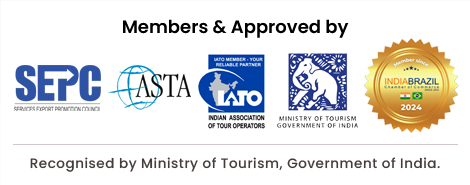L ocated on the Tibetan Plateau, Tibet is nicknamed the 'roof of the world'. Tibet is among the top destinations preferred by travelers, famous for its beauty and spirituality. The country shares the world's highest peak, Mount Everest, with Nepal, which further attracts mountaineers globally. The capital of Tibet, Lhasa, is home to many revered spiritual sites including the world's highest Dzong fortress Potala Palace. Once the winter home of the Dalai Lamas, Lhasa is the spiritual heart of Tibet. Due to its immense natural beauty and spirituality, Tibet has always been a point of interest for passionate travelers from every nook of the planet. The breathtaking Himalayan lakes such as Yamdrok Tso, Namtso, and the sacred Mansarovar display sheer beauty and serenity.
Going back in time, the natural resource of Tibet is unparalleled, which led China to invade Tibet in 1951 and take control of this place. Tibet, surrounded by snow-capped peaks, is home to many glacial lakes that are the source of many rivers, including the Brahmaputra in India and the Yellow River in China. The landscape of Tibet is not all arid. There is some highly fertile and mineral-rich land in the world's highest region. Cultural festivals in Tibet reflect the glamor of Tibetan Buddhism. It hosts emotional dance dramas, exhibitions, and amusement during the famous Shoton Festival held in August. The celebration of Saga Dawa marks the enlightenment of Sakyamuni. The most exciting part of the festival is hovering around Mt Kailash and seeing people of different religions and countries attend.
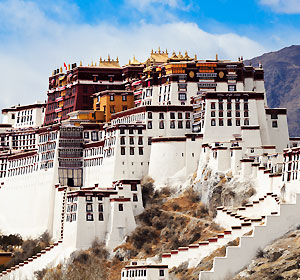
This dzong fortress is the world's highest palace, located at 3750 m. Tibetan king Songtsen Gambo built Potala Palace as a symbol of love after his nuptial union with Princess Wencheng of the Chinese Tang Dynasty. The holiest place in Tibet was the home of the Tibetan Dalai Lamas from 1649 to 1959. It was initially made up of two palaces, Red Palace and White Palace. The palace now acts as a museum listed as a UNESCO world heritage site and is the prime highlight of the Tibet tour.
Towering over Lhasa's capital city, the 117m tall palace fascinates viewers with its architecture and long, rich history. The palace covers an area of over 130,000 square meters and houses four meditation halls and four central halls in the complex dedicated to the 5th Dalai Lama. You can walk through several winding passages and small galleries inside the palace. There are four chapels in the main central hall, also known as the Great West Hall. Many stupas of the Dalai Lamas in different chapels of the palace grab visitors' interest.
Potala palace contains 10,000 shrines, 1,000 rooms, and about 200,000 statues. The most famous is the golden statue of the young Buddha. A total of 432 steps take you to the top of the palace. Located in the central Lhasa, Potala Palace is 2 km north of the Lhasa River, 3 km east of Norbulingka, 5 km south of Sera Monastery, and 2 km west of Jokhang Temple.
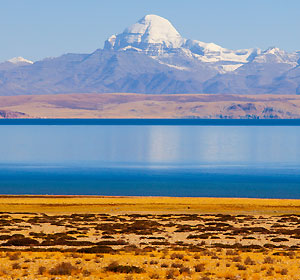
Also known as Mapam Yumtso and Manas Sarovar, this is a high-altitude freshwater lake in Tibet. The lake is fed by Mount Kailash, a sacred pilgrimage place for Hindus devotees. Therefore, every year, many pilgrims opt for the Mansarovar Yatra to visit this sacred lake.
Mansarovar combines two Sanskrit words, Manas meaning mind, and Sarovar meaning Lake. It is believed that Lord Brahma imagined the lake first in his mind and then manifested it on the earth.
Indian Holiday organizes "Kailash Manasarovar Yatra", for pilgrims to visit the lake at an altitude of 4590 m located near Mount Kailash. Hindus, Buddhists, and Jain pilgrims come here to take ceremonial baths in the waters of Mansarovar during this yearly pilgrimage tour.
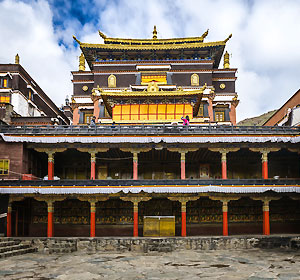
Tashilhunpo Monastery is one of the largest Monasteries in Tibet. It is among the six biggest monasteries operated by the Gelugpa or Yellow Hat Sect of Buddhism. Located at the foot of Drolmari (Tara's Mountain) at Shigatse, Tashilhunpo Monastery is known as the Heap of Glory. The First Dalai Lama established the monastery in 1447. After that, the Fourth and progressive Panchen Lamas further developed the structure of the religious community.
Covering a land of about 300,000 square meters, the main structures include the Maitreya Chapel, The Kelsang Temple, and The Panchen Lama's Palace. Guests can see the remarkable structures with brilliant rooftops and white dividers, the giant Maitreya statue, and stunning Thangkas.
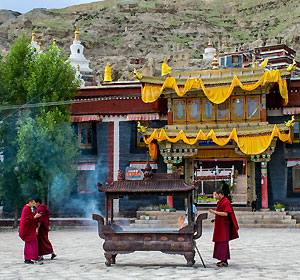
Sakya Monastery is the largest and the most impressive monastery located about 100 miles from Nepal's border in the district of Shigatse in Tibet. It is the trove of Tibetan wall paintings, hallowed Buddhist parchments and books, and thangkas. This monastery is the prime center of the Sakyapa order of Tibetan Buddhism, founded by his holiness Khon Konchog Gyalpo in 1073. The main corridor of the monastery can accommodate 10,000 droning monks. It is home to more than 40,000 hallowed parchments, including the most valuable Burde Gyaimalung.
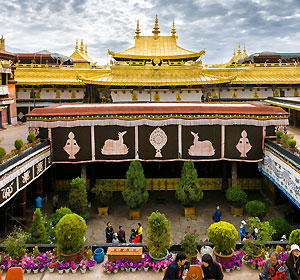
Situated in a prime location of old Lhasa city, Jokhang Temple is a prime highlight of the Tibet tour. The name Jokhang is referred to as the 'Place of Buddha'. The monastery is the prime center of the Gelugpa Sector or the Yellow Branch of Tibetan Buddhism. Jokhang Temple is the holiest destination for all Tibetan Buddhist pioneers initially established in 647 AD. The prime attractions of the monastery are the Life-Sized Sitting Buddha Statue and Tibetan New Year Celebration.
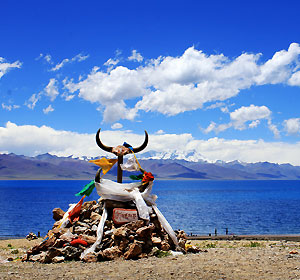
Located at the height of 4718 m and 220 kilometers north of Lhasa, Namtso means 'heavenly or consecrated lake'. This is one of the sacred lakes in Tibet, along with Yamdrok Tso and Mansarovar. Plus, Namtso Lake is the second-largest saltwater lake in China and among the highest of its kind in the world. On your day trip to Namtso Lake from Lhasa, witness the surreal beauty of Namtso Lake, making your day delightful.
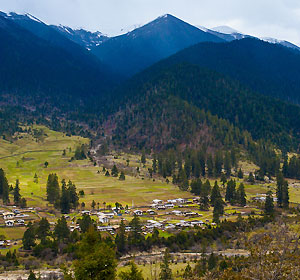
Tibet is a gallery of plants and flowers that makes it a unique place to visit. Lulang Forest is home to such rare plants and colorful flowers, situated around 80 km from Nyingchi County on the Sichuan-Tibet Highway. In Summer, you can experience splendid wheat waves here with refreshing breezes. In Autumn, the leaves of the evergreen pines turn yellow and gradually red. In Winter, snow falls on the woods covering it in a white blanket.
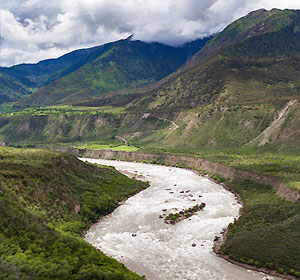
Also known as Tsangpo Gorge or Brahmaputra Canyon, it is the largest canyon in the world. Yarlung Tsangpo Grand Canyon originates at the Angsi Glacier in western Tibet near Mount Kailash. It travels about 500 Km in the South Tibet Valley before entering Arunachal Pradesh in India. Tsangpo Canyon is the Brahmaputra in Assam, India, and becomes Meghna after entering Bangladesh. Winding between two towering peaks, the deepest canyon is a global attraction. The valley fed by this canyon is home to rich wildlife, including some rare plants and exotic animals. You can also explore Buddha Palm Sand Dune, Qujiao Wu Temple, Ping Greeting Guests, and South Jiabawa Peak in the valley.
USEFUL INFORMATION
China controls the Tibet Autonomous Region. Therefore a Tibetan travel permit and a Chinese visa are required to enter this region. The permits allow an individual one entry into Tibet and are valid for three months maximum.
You can search online for the regulations and fees for the Chinese visa and apply accordingly. The easiest way to plan a Tibet tour is to join a tour group. Indian Holiday offers professionally organized tours for a hassle-free trip to Tibet.
BANKS & BUSINESS HOURS
Banks and other offices are operational from Monday to Friday. The working hours in Government offices are from 9 AM China Standard Time to 6 PM with a mid-day break of 1 hour.
Bank of China, Bank of Construct, and Bank of Agriculture are three banks in Tibet located in Lhasa, where a foreign currency exchange is available.
Local Time: GMT + 8
The continental climate of Tibet results in hot summer and freezing winters. Though Lhasa experiences a chilled touch in the summer, you can enjoy pleasant weather during the summer months in Tibet.
From late May or June to September or October, it is the monsoon season in Tibet, with July and August the peak rainy season. Therefore, the best time to visit Tibet is from April to May or September to October to avoid the chilled winter and wet monsoon.
You need to follow the customs rules of China and submit the Customs Baggage Declaration Form while entering the country. You can enter China with a maximum of 5,000 USD (or equivalent in any foreign currency) or 20,000 CNY.
Wildlife, especially endangered species, are strictly prohibited from exporting from here. If you purchase valuable items, such as jewelry, jade, gold and silver ornaments, artifacts, handicrafts, paintings, and calligraphy, keep all the receipts for the exit check.
TRAVELLERS' BAGGAGE ALLOWANCE
The free baggage allowance, including carry-on and check-in baggage, depends on the flight ticket class for each passenger. It is 40 kg for first-class passengers (adult and child), 30 kg for business class passengers, and 20kg for economy class passengers.
DEPARTURE TAX IN TIBET AIRPORT
Airport departure tax, or airport construction fee as they call it, is 50 yuan (about US$6) in domestic airports. You need to pay the fee in cash before check-in. The Departure Tax for international flights is 90 yuan (about US$11).
The currency of Tibet is Renminbi, as in the rest of China. Bank of China in Lhasa offers Foreign Exchange facilities.
There is only one ATM in Lhasa that remains non-operational most of the time. So it would be best if you carried the required cash from your home.
Due to the extreme altitude and cultural factors, there is much environmental stress on the pulmonary system in Tibet. Smoking and spitting in public areas is a common practice in Tibet.
There are four distinct levels of health care facilities available in Tibet. The district or municipal level, the county level, the township level, and the village level.
The district-level hospitals are good enough to treat pulmonary disease. However, the township-level hospitals are the least equipped with only diagnosis and medication.
Zangmu Hydropower Station, located on the Yarlung Zangbo River is the main source of power supply in Tibet. The power plugs and sockets in Tibet are of type A, C and I with the standard voltage 220 V and 50 Hz frequency.
The official language of the Tibet Autonomous Region is the Standard Tibetan, also known as Lhasa Tibetan.
Barkhor Bazaar in Lhasa is one of Tibet's most famous shopping places to buy authentic, local-made souvenirs, Saffron, Buddhist Prayer Beads, etc. Tibetan Jewelry made of pearls, agate, gold, silver, wood, stone, bone, etc., is popular among tourists. You can also buy Tibetan Carpet, Knife, Incense, Medicine, Thangka, etc.
The traditional cuisine of Tibet is strongly based on noodles, butter, cheese, yogurt, goat, mutton, yak, dumplings, and soups. With its unique taste, Tibetan dishes are influenced by mountain life, Buddhist culture, and the neighboring countries of Tibet. Some of the famous dishes of Tibet are Chebureki, Cheser Mog, Chexo, Drokpa Katsa, etc.


